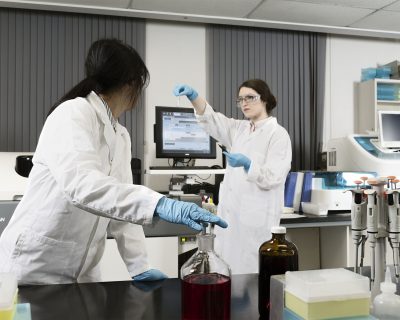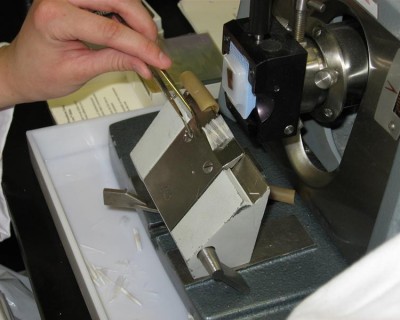Areas of Study
We have six areas of studies in Biomedical Laboratory Technology:
Biochemistry
Biochemistry is the study of chemical processes in living organisms. Students learn about the structure and function of carbohydrates, proteins and lipids and how they relate to cellular function. Students will perform, interpret and correlate body fluid analyses to help assess:
- Cardiac, kidney, liver and hormone function
- Diabetes (glucose and ketone bodies)
- Lipid metabolism (cholesterol, HDL and LDL)
- Toxicology
- Therapeutic drug monitoring
- Proteins and enzymes
- Electrolytes
Along with these analyses students will learn the importance of quality control in order to ensure the accuracy and precision of the results.
Why is Biochemistry important?
A patient is rushed to the hospital with symptoms of a massive heart attack. Blood specimens are sent to the lab for analysis.
Be the one to run the lab tests that will give the doctor some answers in order to treat the patient:
- Did the patient really have a heart attack?
- How extensive is the damage to the heart?
- Will the patient be able to tolerate surgery immediately?
- What is the patient’s risk status regarding future heart attacks?
Hematology
Hematology is the study of blood, blood forming organs and diseases associated with them. Students will learn about the process of blood cell formation, how to perform microscopic examinations of bone marrow and peripheral blood cells and how to investigate blood disorders such as:
- Anemias caused by iron deficiency, B12 and folate deficiencies, hemolytic anemia; and hemoglobiopathies.
- Leukemias
Students will also study Hemostasis, which involves the investigation of bleeding and clotting disorders.
Why is Hematology important?
A patient who recently returned from vacation is constantly feeling weak. A blood sample is taken and sent to the lab.
Be the one to analyze the sample and help figure out what is wrong.
- Does the patient have an anemia?
- Could it be malaria, depending on where the patient went on vacation?
- Do the white blood cells show evidence of a possible leukemia?
- Can it be infectious mononucleosis?
Histology
Histology is the study of microscopic anatomy of cells and tissue. Students will learn the microscopic features of tissues in relation to their respective function and will perform techniques necessary for microscopic observations. Techniques include:
- Grossing, processing and embedding specimens
- Cutting tissues into thin slices and mounting on glass microscope slides
- Staining and microscopic examination
- Assessement of tissue integrity and adequacy of staining
Why is Histology important?
A patient goes to see her physician after noticing a lump on her breast. A biopsy (removal of a small piece of tissue) is performed and sent to the lab.
Be the one to help in analyzing, diagnosing and determining the treatment:
- How will the biopsy tissue be prepared for proper analysis?
- Which types of special stains should be used to detect any abnormalities in the tissue?
- Will tumor markers be necessary to classify the cancer?
- Which tests would predict the most effective treatment for this type of cancer?
Microbiology
Clinical Microbiology is the study of bacteria that cause human disease. The field encompasses the detection and identification of bacterial pathogens, determination of the sensitivity and mechanisms of resistance of bacteria to antibiotics, and the mechanisms of virulence, and some aspects of immunity to infection.
The clinical microbiology laboratory identifies bacterial pathogens present in specimens such as:
- urine
- stool
- sputum
- pus
- blood
- spinal fluid
- swabs of skin, throat, rectum, or urogenital surfaces.
Identification involves staining and microscopic examination of these materials and isolation of bacteria present in the specimen by growth on appropriate agar media. The laboratory must differentiate bacterial pathogens from bacteria that normally colonize humans. Bacterial species can be identified and differentiated on the basis of growth properties, metabolic and biochemical tests, and reactivity with specific antibodies.
Why is Microbiology important?
A patient comes to the patient emergency room in pain. Soon after, his appendix bursts and the patient quickly develops fever. A blood culture is taken from the patient and sent to the lab for analysis.
Be the one to process the blood culture in order to determine if there is an infection in the patient’s blood:
- Are there any bacteria in the blood?
- Which bacteria are present that could be causing an infection?
- Which antibiotics are most effective against this particular bacteria?
- Is this bacteria an antibiotic-resistant strain?
Molecular Biology
Molecular Biology is the study of biology at a molecular level, including DNA, RNA and proteins. Molecular Diagnostics is the analysis of genetic sequence variations or gene expression for medical purposes, and involves the detection of specific DNA/RNA sequences or specific proteins.
Students will learn about the structure and function of nucleic acids in cells, and about key molecular diagnostics techniques, including PCR and DNA sequencing. Students will also learn about applications of these techniques in the areas of:
- Infectious disease
- Inherited conditions
- Oncology
Why is Molecular Biology important?
A patient has recently experienced a blood clot in their leg, and the doctor suspects that they may have an inherited clotting disorder. A blood sample is taken from the patient and sent to the lab for analysis.
Be the one to process and analyze the sample, and to help the doctor diagnose the patient:
- How should the specimen be prepared to ensure accurate analysis?
- Does the patient have an inherited clotting disorder caused by a genetic mutation?
- Does the patient have one copy of the mutation or two copies?
- How high is the patient’s risk of having another blood clot?
- Should genetic testing be recommended for this patient’s relatives?
Transfusion Science
Transfusion science is the study that deals with the immunological properties of blood. Students will learn about the transfusion of blood and blood products. Students will perform and interpret all necessary techniques in order to perform these functions including:
- Blood typing
- Antibody detection and identification
- Compatibility testing for donor blood transfusion
- Prenatal testing
- Blood component therapy
Why is Transfusion Science important?
After a car accident, a patient with massive blood loss is brought to your hospital’s emergency room. The doctor requests blood for transfusion.
Be the one to test the patient’s blood and ensure that the patient receives the blood products that will save his life:
- Does the patient have any antibodies that could react with the donor blood?
- Does the patient need plasma and platelets as well?
- Are there any special considerations, such as bleeding disorders, that must be taken into account for this patient?
- Is there compatible donor blood available for this patient?
The training that technologists receive prepares them to:
- Use highly specialized instruments and techniques to analyze body tissues and fluids and identify microorganisms
- Help with patient diagnosis and with research into medical conditions and treatments
- Work as part of a team
- Procure laboratory specimens and communicate effectively with patients
- Work in many different venues, including clinical, research and pharmaceutical settings
First and second year students:
- Acquire theoretical knowledge of all six major medical specialties in the classroom components of their courses
- Develop and practice their laboratory skills in the laboratory components of their courses
- At the end of the fourth term, second year students will complete a 1 week procurement internship.
- Second year students are allowed to work in hospital clinical laboratories during the summer and Christmas holiday period as “externs”. Students must have completed all courses in the first and second year and must be a student member of the OPTMQ.
Third year students:
- Continue with on-the-job training during a 25 week internship in which they rotate through the major clinical laboratories in accredited hospitals.












